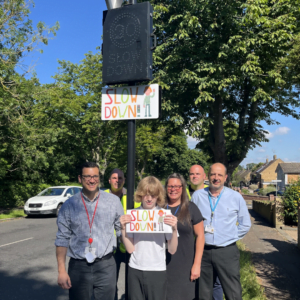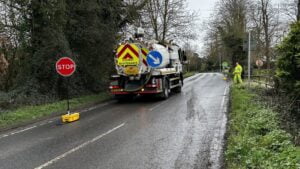A trial to reduce traffic cutting through local streets in Fenham, in Newcastle ends on 8 September and will not be made permanent.
Fenham was the first area of the city to pilot a neighbourhood low traffic zone trial
A trial to reduce traffic cutting through local streets in Fenham ends on 8 September and will not be made permanent.
Several streets were closed to through traffic in March 2022 as part of an 18-month trial scheme to reduce the volume of traffic using local streets by rerouting through traffic on to more appropriate routes. Using Experimental Traffic Regulation Orders, public consultation ran within the first six months of the scheme being installed.
With the trial period due to end in the coming days, the council has reviewed the scheme, alongside data collected and feedback from the public, and decided that the traffic changes will not be made permanent due to the displacement of traffic on residential streets.
The measures to close the junction of Queensway and Kingsway to through traffic, as well as Gowland Avenue and Nuns Moor Road, near to the junctions with Bolbec Road and Cedar Road will be removed by 7 September.
Having the closures in place has seen significant reductions in traffic for people living next to them on Nuns Moor Road and the north end of Queensway and Kingsway.
Data from the trial shows that while the main road network of Fenham Hall Drive, Wingrove Road and Hadrian Road have all seen an overall intended increase in vehicle usage, traffic counts suggest that through traffic is using alternative residential routes to access these streets rather than remaining on them.
This has resulted in an increase in traffic on to neighbouring streets including Queensway (south of Alder Avenue), Kingsway (at its junction with Fenham Hall Drive), Brand Avenue, Severus Road and Sutherland Avenue.
Cllr Jane Byrne, cabinet member for a connected, clean city said: “We’re committed to creating cleaner, greener and safer neighbourhoods and reducing the volume of traffic cutting through local streets is an important part in achieving this.
“Fenham was the first area of the city to pilot a neighbourhood low traffic zone trial and we haven’t seen enough evidence to keep it in place, particularly with the displacement of traffic on to what should be quiet residential streets, rather than rerouting onto the main roads.
“As we have said many times, these schemes are trials which are really important as they allow us to try the changes in local areas and see what works for people living in the zone.
“We also know that some people will be disappointed, but we’ve taken a lot of learning from the scheme, and we have a good basis for refining a future scheme by listening to residents and looking at the data in more detail.
“It is also important to note, that each neighbourhood low traffic zone is unique, as we use the data we collect alongside feedback from the public consultation, in deciding on the long-term future of individual schemes.”
Other permanent measures including those announced at the same time as the trial, will continue later this year. This includes a school crossing for Hadrian Road, traffic calming on Wingrove Road and Wingrove Avenue, and yellow lines at the junction of Bourne Avenue and Fowberry Crescent.
In addition, the junction tightening at Bolbec Road and Cedar Road will be made permanent; alongside further junction tightening for Gowland Avenue (at the Cedar Road and Hadrian Road junctions) to deter speeding.
The council will remove the closures at Kingsway/Queensway, Gowland Avenue and Nuns Moor Road by 7 September. Traffic counters will remain in place. This traffic data and discussions with residents will inform new proposals for the area, which could be installed in Summer of 2024.
Headline figures from the data reveal:
- Significant reduction in vehicular traffic adjacent to the closures on Queensway, Kingsway, and Nuns Moor Road.
- Nuns Moor Road saw an 80.46% decrease in average weekday vehicle count from 2,032 vehicles (Pre-closure, March 2022) to 397 (Post-closure, Sep 2022).
- Kingsway / Queensway (close to its closure) saw an 83.7% decrease in average weekday count from around 847 vehicles (Pre-closure, March 2022) to around 138 (Post-closure, Sep 2022).
- Reduced traffic levels on Cypress Avenue because of the Kingsway/Queensway closure.
- Cypress Avenue saw a 20% decrease in average weekday count from around 2,000 vehicles (Pre-closure, March 2022) to around 1,600 (Post-closure, Sep 2022).
- Increased levels of displaced traffic using alternative residential streets such as Queensway (south of Alder Avenue), Kingsway (at its junction with Fenham Hall Drive), Brand Avenue, Severus Road and Sutherland Avenue.
- Queensway (south of Alder Avenue) saw a 154.25% increase in average weekday vehicle count from 706 vehicles (Pre- LTN, March 2022) to 1795 (Post-LTN, Sep 2022).
- Sutherland Avenue saw an 59.41% increase in average weekday vehicle count from 446 vehicles (Pre- LTN, March 2022) to 711 (Post-LTN, Sep 2022).
- Severus Road saw a 14.78% increase in average weekday vehicle count from 555 vehicles (Pre- LTN, March 2022) to 637 (Post-LTN, July 2023).
- Brand Avenue saw an average weekday count of 1065 vehicles after LTN measures. It is understood that this is a significant increase comparing to other adjacent streets.
- Kingsway (at its junction with Fenham Hall Drive) saw a 14.44% increase in average weekday vehicle count from 478 vehicles (Pre- LTN, March 2022) to 547 (Post-LTN, September 2022).
- The closures have resulted in little impact on Bolbec Road with traffic levels consistent with pre-implementation data.





















